Sandro Pezzelle
CIMeC - Center for Mind/Brain Sciences, University of Trento
Are formal and functional linguistic mechanisms dissociated?
Mar 14, 2025Abstract:Although large language models (LLMs) are increasingly capable, these capabilities are unevenly distributed: they excel at formal linguistic tasks, such as producing fluent, grammatical text, but struggle more with functional linguistic tasks like reasoning and consistent fact retrieval. Inspired by neuroscience, recent work suggests that to succeed on both formal and functional linguistic tasks, LLMs should use different mechanisms for each; such localization could either be built-in or emerge spontaneously through training. In this paper, we ask: do current models, with fast-improving functional linguistic abilities, exhibit distinct localization of formal and functional linguistic mechanisms? We answer this by finding and comparing the "circuits", or minimal computational subgraphs, responsible for various formal and functional tasks. Comparing 5 LLMs across 10 distinct tasks, we find that while there is indeed little overlap between circuits for formal and functional tasks, there is also little overlap between formal linguistic tasks, as exists in the human brain. Thus, a single formal linguistic network, unified and distinct from functional task circuits, remains elusive. However, in terms of cross-task faithfulness - the ability of one circuit to solve another's task - we observe a separation between formal and functional mechanisms, suggesting that shared mechanisms between formal tasks may exist.
From Tools to Teammates: Evaluating LLMs in Multi-Session Coding Interactions
Feb 19, 2025Abstract:Large Language Models (LLMs) are increasingly used in working environments for a wide range of tasks, excelling at solving individual problems in isolation. However, are they also able to effectively collaborate over long-term interactions? To investigate this, we introduce MemoryCode, a synthetic multi-session dataset designed to test LLMs' ability to track and execute simple coding instructions amid irrelevant information, simulating a realistic setting. While all the models we tested handle isolated instructions well, even the performance of state-of-the-art models like GPT-4o deteriorates when instructions are spread across sessions. Our analysis suggests this is due to their failure to retrieve and integrate information over long instruction chains. Our results highlight a fundamental limitation of current LLMs, restricting their ability to collaborate effectively in long interactions.
Natural Language Generation from Visual Sequences: Challenges and Future Directions
Feb 18, 2025Abstract:The ability to use natural language to talk about visual content is at the core of human intelligence and a crucial feature of any artificial intelligence system. Various studies have focused on generating text for single images. In contrast, comparatively little attention has been paid to exhaustively analyzing and advancing work on multiple-image vision-to-text settings. In this position paper, we claim that any task dealing with temporally ordered sequences of multiple images or frames is an instance of a broader, more general problem involving the understanding of intricate relationships between the visual content and the corresponding text. We comprehensively analyze five tasks that are instances of this problem and argue that they pose a common set of challenges and share similarities in terms of modeling and evaluation approaches. Based on the insights from these various aspects and stages of multi-image-to-text generation, we highlight several open questions and suggest future research directions. We believe that these directions can advance the understanding of complex phenomena in this domain and the development of better models.
Modelling Multimodal Integration in Human Concept Processing with Vision-and-Language Models
Jul 25, 2024Abstract:Representations from deep neural networks (DNNs) have proven remarkably predictive of neural activity involved in both visual and linguistic processing. Despite these successes, most studies to date concern unimodal DNNs, encoding either visual or textual input but not both. Yet, there is growing evidence that human meaning representations integrate linguistic and sensory-motor information. Here we investigate whether the integration of multimodal information operated by current vision-and-language DNN models (VLMs) leads to representations that are more aligned with human brain activity than those obtained by language-only and vision-only DNNs. We focus on fMRI responses recorded while participants read concept words in the context of either a full sentence or an accompanying picture. Our results reveal that VLM representations correlate more strongly than language- and vision-only DNNs with activations in brain areas functionally related to language processing. A comparison between different types of visuo-linguistic architectures shows that recent generative VLMs tend to be less brain-aligned than previous architectures with lower performance on downstream applications. Moreover, through an additional analysis comparing brain vs. behavioural alignment across multiple VLMs, we show that -- with one remarkable exception -- representations that strongly align with behavioural judgments do not correlate highly with brain responses. This indicates that brain similarity does not go hand in hand with behavioural similarity, and vice versa.
Not (yet) the whole story: Evaluating Visual Storytelling Requires More than Measuring Coherence, Grounding, and Repetition
Jul 05, 2024Abstract:Visual storytelling consists in generating a natural language story given a temporally ordered sequence of images. This task is not only challenging for models, but also very difficult to evaluate with automatic metrics since there is no consensus about what makes a story 'good'. In this paper, we introduce a novel method that measures story quality in terms of human likeness regarding three key aspects highlighted in previous work: visual grounding, coherence, and repetitiveness. We then use this method to evaluate the stories generated by several models, showing that the foundation model LLaVA obtains the best result, but only slightly so compared to TAPM, a 50-times smaller visual storytelling model. Upgrading the visual and language components of TAPM results in a model that yields competitive performance with a relatively low number of parameters. Finally, we carry out a human evaluation study, whose results suggest that a 'good' story may require more than a human-like level of visual grounding, coherence, and repetition.
LLMs instead of Human Judges? A Large Scale Empirical Study across 20 NLP Evaluation Tasks
Jun 26, 2024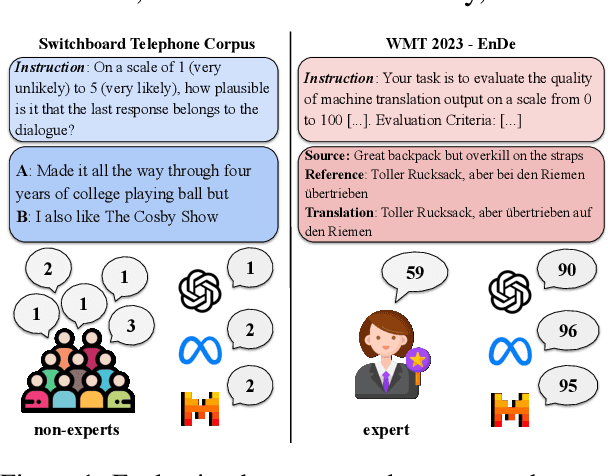
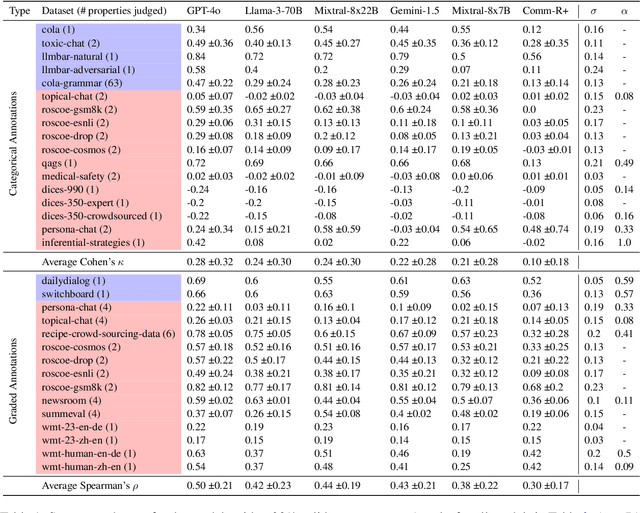
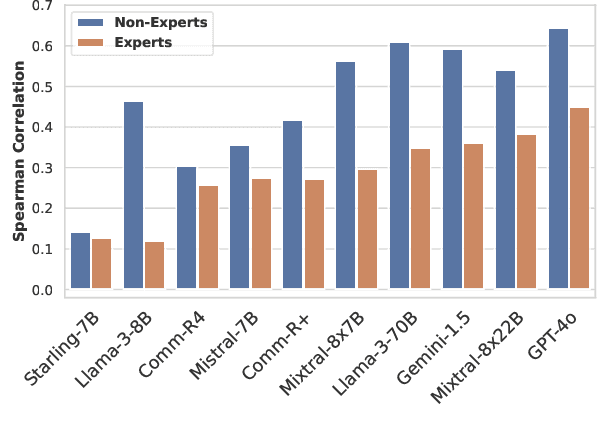
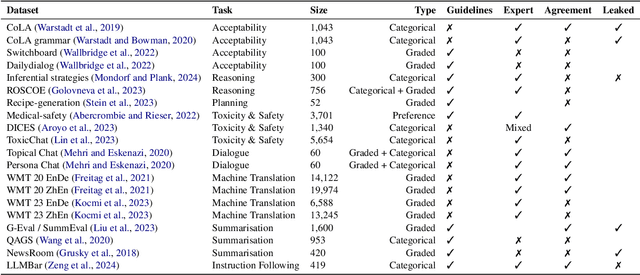
Abstract:There is an increasing trend towards evaluating NLP models with LLM-generated judgments instead of human judgments. In the absence of a comparison against human data, this raises concerns about the validity of these evaluations; in case they are conducted with proprietary models, this also raises concerns over reproducibility. We provide JUDGE-BENCH, a collection of 20 NLP datasets with human annotations, and comprehensively evaluate 11 current LLMs, covering both open-weight and proprietary models, for their ability to replicate the annotations. Our evaluations show that each LLM exhibits a large variance across datasets in its correlation to human judgments. We conclude that LLMs are not yet ready to systematically replace human judges in NLP.
Have Faith in Faithfulness: Going Beyond Circuit Overlap When Finding Model Mechanisms
Mar 26, 2024Abstract:Many recent language model (LM) interpretability studies have adopted the circuits framework, which aims to find the minimal computational subgraph, or circuit, that explains LM behavior on a given task. Most studies determine which edges belong in a LM's circuit by performing causal interventions on each edge independently, but this scales poorly with model size. Edge attribution patching (EAP), gradient-based approximation to interventions, has emerged as a scalable but imperfect solution to this problem. In this paper, we introduce a new method - EAP with integrated gradients (EAP-IG) - that aims to better maintain a core property of circuits: faithfulness. A circuit is faithful if all model edges outside the circuit can be ablated without changing the model's performance on the task; faithfulness is what justifies studying circuits, rather than the full model. Our experiments demonstrate that circuits found using EAP are less faithful than those found using EAP-IG, even though both have high node overlap with circuits found previously using causal interventions. We conclude more generally that when using circuits to compare the mechanisms models use to solve tasks, faithfulness, not overlap, is what should be measured.
Naming, Describing, and Quantifying Visual Objects in Humans and LLMs
Mar 13, 2024Abstract:While human speakers use a variety of different expressions when describing the same object in an image, giving rise to a distribution of plausible labels driven by pragmatic constraints, the extent to which current Vision \& Language Large Language Models (VLLMs) can mimic this crucial feature of language use is an open question. This applies to common, everyday objects, but it is particularly interesting for uncommon or novel objects for which a category label may be lacking or fuzzy. Furthermore, humans show clear production preferences for highly context-sensitive expressions, such as the quantifiers `few' or `most'. In our work, we evaluate VLLMs (FROMAGe, BLIP-2, LLaVA) on three categories (nouns, attributes, and quantifiers) where humans show great subjective variability concerning the distribution over plausible labels, using datasets and resources mostly under-explored in previous work. Our results reveal mixed evidence on the ability of VLLMs to capture human naming preferences, with all models failing in tasks that require high-level reasoning such as assigning quantifiers.
Do Pre-Trained Language Models Detect and Understand Semantic Underspecification? Ask the DUST!
Feb 19, 2024



Abstract:In everyday language use, speakers frequently utter and interpret sentences that are semantically underspecified, namely, whose content is insufficient to fully convey their message or interpret them univocally. For example, to interpret the underspecified sentence "Don't spend too much", which leaves implicit what (not) to spend, additional linguistic context or outside knowledge is needed. In this work, we propose a novel Dataset of semantically Underspecified Sentences grouped by Type (DUST) and use it to study whether pre-trained language models (LMs) correctly identify and interpret underspecified sentences. We find that newer LMs are reasonably able to identify underspecified sentences when explicitly prompted. However, interpreting them correctly is much harder for any LMs. Our experiments show that when interpreting underspecified sentences, LMs exhibit little uncertainty, contrary to what theoretical accounts of underspecification would predict. Overall, our study reveals limitations in current models' processing of sentence semantics and highlights the importance of using naturalistic data and communicative scenarios when evaluating LMs' language capabilities.
Describing Images $\textit{Fast and Slow}$: Quantifying and Predicting the Variation in Human Signals during Visuo-Linguistic Processes
Feb 02, 2024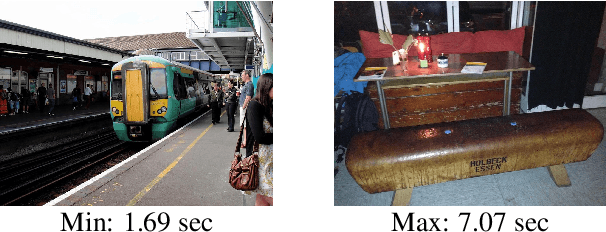
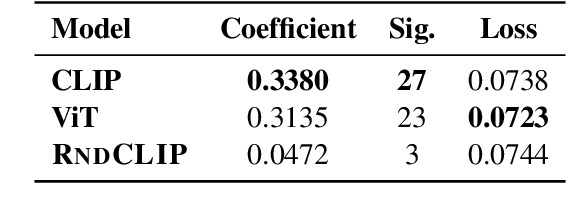
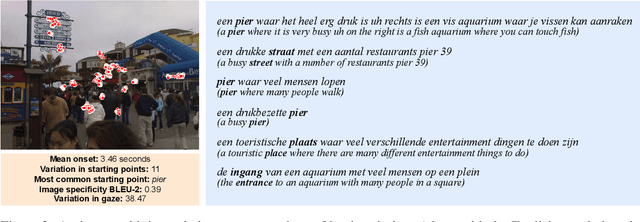
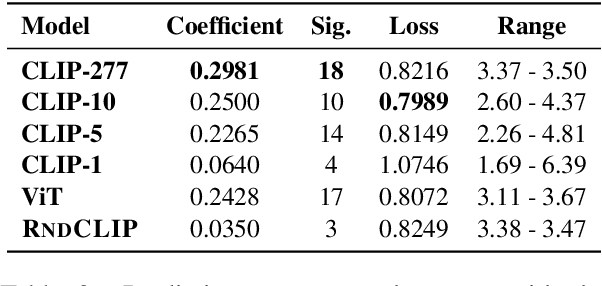
Abstract:There is an intricate relation between the properties of an image and how humans behave while describing the image. This behavior shows ample variation, as manifested in human signals such as eye movements and when humans start to describe the image. Despite the value of such signals of visuo-linguistic variation, they are virtually disregarded in the training of current pretrained models, which motivates further investigation. Using a corpus of Dutch image descriptions with concurrently collected eye-tracking data, we explore the nature of the variation in visuo-linguistic signals, and find that they correlate with each other. Given this result, we hypothesize that variation stems partly from the properties of the images, and explore whether image representations encoded by pretrained vision encoders can capture such variation. Our results indicate that pretrained models do so to a weak-to-moderate degree, suggesting that the models lack biases about what makes a stimulus complex for humans and what leads to variations in human outputs.
 Add to Chrome
Add to Chrome Add to Firefox
Add to Firefox Add to Edge
Add to Edge